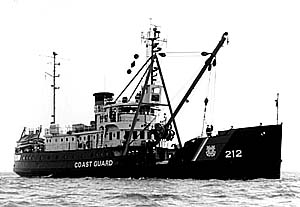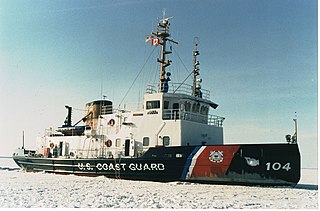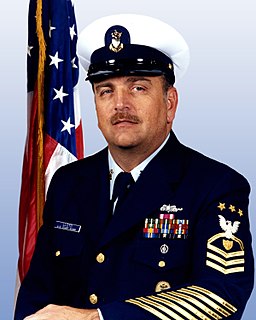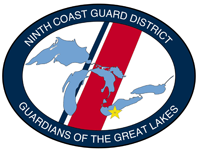
USCGC Acushnet (WMEC-167) was a cutter of the United States Coast Guard, homeported in Ketchikan, Alaska. She was originally USS Shackle (ARS-9), a Diver-class rescue and salvage ship commissioned by the United States Navy for service in World War II. She was responsible for coming to the aid of stricken vessels and received three battle stars during World War II, before a long career with the Coast Guard. Acushnet patrolled the waters of the North Pacific and was one of the last World War II era ships on active duty in the US fleet upon her retirement in 2011.

The Bay-class tugboat is a class of 140-foot (43 m) icebreaking tugboats of the United States Coast Guard, with hull numbers WTGB-101 through to WTGB-109.

USS Edisto (AGB-2) was a Wind-class icebreaker in the service of the United States Navy and was later transferred to the United States Coast Guard as USCGC Edisto (WAGB-284). She was named after Edisto Island, South Carolina. The island is named after the Native American Edisto Band who inhabited the island and the surrounding area. As of 2011 there is a namesake cutter USCGC Edisto (WPB-1313). The newer Edisto is a 110-foot Island-class patrol boat and is stationed in San Diego County, California.

USCGC Bramble (WLB-392) is one of the 39 original 180-foot (55 m) seagoing buoy tenders built between 1942 and 1944 for the United States Coast Guard. In commission from 1944 until 2003 she saw service in Pacific, Caribbean and Atlantic waters as well as the Great Lakes. In 1947 Bramble was present at the Nuclear testing at Bikini Atoll and in 1957 a circumnavigation of North America involved a forced traverse of the Northwest Passage. After decommissioning in 2003 Bramble became a museum ship in Port Huron, Michigan. In 2018 she was sold to a private owner, who is preparing MV Bramble to repeat her historic 1957 circumnavigation of North America.

USCGC Northwind (WAG/WAGB-282) was a Wind-class icebreaker, the second United States Coast Guard Cutter of her class to bear the name. She was built to replace USCGC Staten Island which was in Soviet lend-lease service.

USCGC Spar (WLB-206) is a United States Coast Guard Juniper-Class seagoing buoy tender home-ported in Duluth, Minnesota. The ship maintains aids to navigation in the Twin Ports and Great Lakes.

USCGC Campbell (WMEC-909) is a United States Coast Guard medium endurance cutter based at Naval Station Newport in Newport, Rhode Island. Campbell is the sixth Coast Guard Cutter to bear the name and is assigned to the Atlantic. The ship bears the distinction of having made some of the largest narcotics seizures in Coast Guard history as well as being the command ship for the TWA 800 recovery effort.

USCGC Vigorous (WMEC-627) is a United States Coast Guard Reliance Class medium endurance cutter.

The United States Coast Guard Cutter Fir was the last lighthouse tender built specifically for the United States Lighthouse Service to resupply lighthouses and lightships, and to service buoys. Fir was built by the Moore Drydock Company in Oakland, California in 1939. On 22 March 1939, the U.S. Lighthouse Tender Fir was launched. She was steam driven with twin screws, 175 feet (53 m) in length, had a beam of 32 feet (9.8 m), drew 11 feet 3 inches (3.43 m) of water, and displaced 885 tons. Fir was fitted with a reinforced bow and stern, and an ice-belt at her water-line for icebreaking. She was built with classic lines and her spaces were lavishly appointed with mahogany, teak, and brass. The crew did intricate ropework throughout the ship. The cost to build Fir was approximately US$390,000. Fir's homeport was Seattle, Washington for all but one of her fifty one years of service when she was temporarily assigned to Long Beach, California when USCGC Walnut was decommissioned on 1 July 1982.

Ronald James Rábago is a retired United States Coast Guard rear admiral who in 2006 became the first person of Hispanic American descent to be promoted to flag rank in the United States Coast Guard. He retired as the assistant commandant for engineering and logistics and the United States Coast Guard's chief engineer in 2014.

USCGC Biscayne Bay (WTGB-104) is a United States Coast Guard Cutter and an icebreaking tug. She is based at Coast Guard Station St. Ignace with a primary area of operation in the Straits of Mackinac including Mackinac Island, Mackinac Bridge, and the northern portions of Lakes Michigan and Huron and occasionally Lakes Superior, Erie and their connecting rivers. Beyond her role as an icebreaker, Biscayne Bay performs search and rescue and law enforcement functions.

Robert Jay Lloyd was the sixth Master Chief Petty Officer of the Coast Guard, serving as the enlisted advisor to the Commandant of the Coast Guard, from 1990 to 1994.

District 9 is a United States Coast Guard district located at the Anthony J. Celebrezze Federal Building in Cleveland, Ohio. District 9 is responsible for all Coast Guard operations on the five Great Lakes, the Saint Lawrence Seaway, and surrounding states accumulating 6,700 miles of shoreline and 1,500 miles of international shoreline with Canada.

USCGC Penobscot Bay is the seventh of nine United States Coast Guard 140-foot Bay-class icebreaking tugs. Homeported in Bayonne, New Jersey, the primary missions of Penobscot Bay and her crew are Domestic Icebreaking and Ports, Waterways, & Coastal Security. During the winter months, Penobscot Bay is responsible for providing search and rescue capabilities to the ice-covered areas in New York City and the Hudson Valley, as well as throughout coastal New England. The cutter also facilitates the safe navigation of commercial product, including gasoline and heating oil, through the ice-choked Hudson River from New York City to Albany. All Bay-class cutters, including Penobscot Bay, use a low-pressure-air hull lubrication or bubbler system that forces air and water between the hull and ice. This system improves icebreaking capabilities by reducing resistance against the hull, reducing horsepower requirements.

The following January 2019 order of battle is for the United States Coast Guard.

USS YF-416 was an American YF-257-class covered lighter built in 1943 for service in World War II. She was later acquired by the United States Coast Guard and renamed USCGC White Sumac (WAGL-540).

USCGC Bristol Bay (WTGB-102) is the second vessel of the Bay-class tugboats built in 1978 and operated by the United States Coast Guard. The ship was named after the body of water formed by the Alaskan peninsula, which emptied into the Bering Sea.

USCGC Neah Bay (WTGB-105) is the fifth vessel of the Bay-class tugboat built in 1980 and operated by the United States Coast Guard. The ship was named after a bay located within the state of Washington and bordered by Puget Sound.

USCGC Thunder Bay (WTGB-108) is the eighth vessel of the Bay-class tugboat built in 1985 and operated by the United States Coast Guard. The ship was named after a bay in the U.S. state of Michigan on Lake Huron.

USCGC Hollyhock (WAGL-220) was the lead ship of the Hollyhock-class buoy tender built in 1937 and operated by the United States Coast Guard. The ship was named after an annual, biennial, or perennial plant usually taking an erect, unbranched form.



















